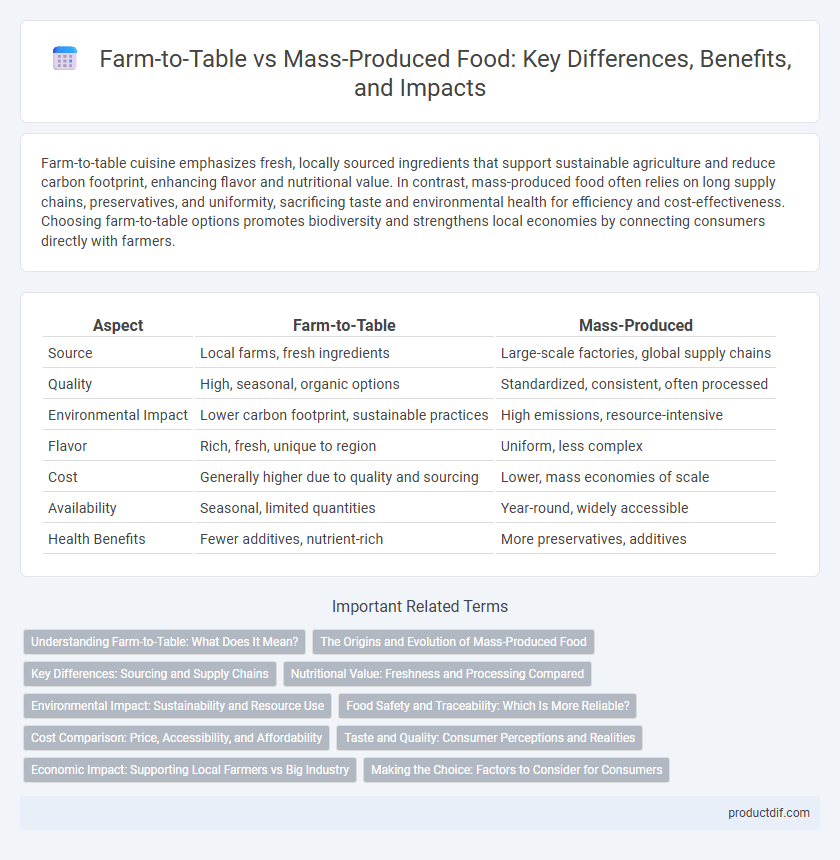Farm-to-table cuisine emphasizes fresh, locally sourced ingredients that support sustainable agriculture and reduce carbon footprint, enhancing flavor and nutritional value. In contrast, mass-produced food often relies on long supply chains, preservatives, and uniformity, sacrificing taste and environmental health for efficiency and cost-effectiveness. Choosing farm-to-table options promotes biodiversity and strengthens local economies by connecting consumers directly with farmers.
Table of Comparison
| Aspect | Farm-to-Table | Mass-Produced |
|---|---|---|
| Source | Local farms, fresh ingredients | Large-scale factories, global supply chains |
| Quality | High, seasonal, organic options | Standardized, consistent, often processed |
| Environmental Impact | Lower carbon footprint, sustainable practices | High emissions, resource-intensive |
| Flavor | Rich, fresh, unique to region | Uniform, less complex |
| Cost | Generally higher due to quality and sourcing | Lower, mass economies of scale |
| Availability | Seasonal, limited quantities | Year-round, widely accessible |
| Health Benefits | Fewer additives, nutrient-rich | More preservatives, additives |
Understanding Farm-to-Table: What Does It Mean?
Farm-to-table refers to a food sourcing approach emphasizing local, fresh ingredients directly from farms to consumers, minimizing processing and transportation. This method supports sustainable agriculture, reduces carbon footprint, and enhances nutritional value by offering seasonal produce. Unlike mass-produced food, which relies on large-scale industrial farming and extensive supply chains, farm-to-table promotes transparency, quality, and environmental responsibility.
The Origins and Evolution of Mass-Produced Food
Mass-produced food originated during the Industrial Revolution, driven by technological advancements like mechanized farming, refrigeration, and mass transportation that enabled large-scale production and distribution. This evolution prioritized efficiency, cost reduction, and extended shelf life, often relying on standardized recipes and preservatives to meet growing urban populations' demands. The shift transformed food systems from localized, diverse sources to centralized factories, fundamentally altering agricultural practices and consumer habits worldwide.
Key Differences: Sourcing and Supply Chains
Farm-to-table emphasizes locally sourced ingredients often harvested directly from nearby farms, ensuring freshness and supporting regional agriculture. Mass-produced food relies on large-scale industrial supply chains that span multiple regions and countries, prioritizing cost-efficiency and high volume. The farm-to-table approach minimizes transportation and processing, while mass production involves extensive distribution networks and often longer shelf lives due to preservatives.
Nutritional Value: Freshness and Processing Compared
Farm-to-table foods retain higher nutritional value due to minimal processing and rapid delivery from harvest to consumption, preserving essential vitamins and antioxidants. Mass-produced foods often undergo extended storage and industrial processing, which leads to nutrient degradation and loss of freshness. Consumers seeking maximum nutritional benefits and superior taste typically prefer farm-to-table options over mass-produced alternatives.
Environmental Impact: Sustainability and Resource Use
Farm-to-table practices significantly reduce carbon footprints by minimizing transportation distances and promoting local biodiversity, unlike mass-produced food systems that rely heavily on fossil fuels and intensive monoculture farming. Sustainable resource use in farm-to-table models emphasizes regenerative agriculture techniques, conserving soil health and water resources, whereas mass-produced agriculture often leads to soil degradation, excessive water consumption, and increased greenhouse gas emissions. Prioritizing farm-to-table methods supports environmental sustainability by fostering ecosystem balance and reducing waste throughout the food supply chain.
Food Safety and Traceability: Which Is More Reliable?
Farm-to-table food offers enhanced traceability through transparent supply chains, allowing consumers to verify the origin and handling of ingredients, which significantly reduces contamination risks. Mass-produced food relies on standardized safety protocols and large-scale inspections but faces challenges in tracking every batch due to complex distribution networks. Therefore, farm-to-table systems generally provide more reliable food safety assurance by enabling direct monitoring and faster response to potential hazards.
Cost Comparison: Price, Accessibility, and Affordability
Farm-to-table produce often commands higher prices due to smaller scale operations and premium quality, whereas mass-produced food benefits from economies of scale, reducing unit costs significantly. Accessibility varies as mass-produced items are widely available in supermarkets, while farm-to-table options may be limited to farmers' markets or specialty stores. Affordability depends on budget constraints and priorities; consumers seeking fresh, local produce might accept higher costs, whereas price-sensitive shoppers gravitate towards cheaper, mass-produced alternatives.
Taste and Quality: Consumer Perceptions and Realities
Farm-to-table food is often perceived as fresher and more flavorful due to its shorter supply chain and minimal processing, enhancing taste and quality. Mass-produced food, while consistent and widely accessible, may compromise on freshness and nutrient density because of longer storage and transportation times. Consumer preferences reflect a growing demand for farm-to-table options as they associate them with superior taste, higher quality ingredients, and more authentic food experiences.
Economic Impact: Supporting Local Farmers vs Big Industry
Supporting local farmers through farm-to-table initiatives stimulates regional economies by increasing demand for locally grown produce and creating jobs within communities. Mass-produced food systems generate higher volumes at lower costs but often divert profits to large corporations, limiting economic benefits for small-scale farmers. Investing in farm-to-table practices promotes sustainable economic growth by retaining wealth within local agricultural sectors and fostering resilient food networks.
Making the Choice: Factors to Consider for Consumers
Consumers choosing between farm-to-table and mass-produced food should consider factors such as freshness, nutritional value, and environmental impact. Farm-to-table options often offer higher nutrient density and support sustainable farming practices, while mass-produced foods provide convenience and lower cost. Evaluating personal health goals, budget constraints, and commitment to sustainability helps guide the decision.
farm-to-table vs mass-produced Infographic

 productdif.com
productdif.com